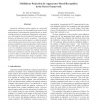5 search results - page 1 / 1 » Matrix identities and the pigeonhole principle |
AML
2004
13 years 5 months ago
2004
We show that short bounded-depth Frege proofs of matrix identities, such as P Q = I QP = I (over the field of two elements), imply short bounded-depth Frege proofs of the pigeonho...
SIAMJO
2011
12 years 8 months ago
2011
Suppose we are given a matrix that is formed by adding an unknown sparse matrix to an unknown low-rank matrix. Our goal is to decompose the given matrix into its sparse and low-ran...
BMCBI
2006
13 years 5 months ago
2006
Background: Owing to rapid expansion of protein structure databases in recent years, methods of structure comparison are becoming increasingly effective and important in revealing...
ICCV
2007
IEEE
14 years 2 days ago
2007
IEEE
Numerical multilinear (tensor) algebra is a principled mathematical approach to disentangling and explicitly and parsimoniously representing the essential factors or modes of imag...
WWW
2005
ACM
14 years 6 months ago
2005
ACM
PageRank is defined as the stationary state of a Markov chain depending on a damping factor that spreads uniformly part of the rank. The choice of is eminently empirical, and in...


